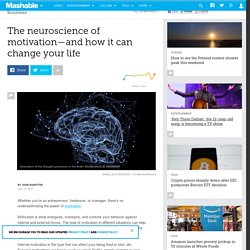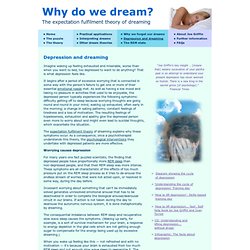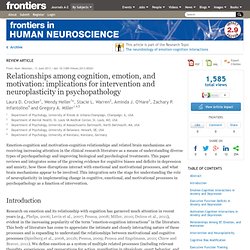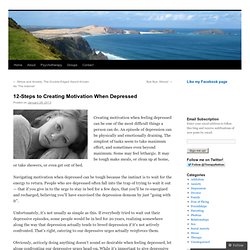

Implementation Intentions. To work or not to work: Neural representation of cost and benefit of instrumental action. JavaScript is disabled on your browser.

Please enable JavaScript to use all the features on this page. Abstract By definition, instrumental actions are performed in order to obtain certain goals. Nevertheless, the attainment of goals typically implies obstacles, and response vigor is known to reflect an integration of subjective benefit and cost. Whereas several brain regions have been associated with cost/benefit ratio decision-making, trial-by-trial fluctuations in motivation are not well understood. Keywords Response vigor Striatum Effort Action control Motivation fMRI Dopamine Utility Reward Choose an option to locate/access this article: How to Turn on the Part of Your Brain That Controls Motivation. The neuroscience of motivation—and how it can change your life. Whether you’re an entrepreneur, freelancer, or manager, there’s no underestimating the power of motivation.

Motivation is what energizes, maintains, and controls your behavior against internal and external forces. The type of motivation in different situations can help you excel. The type of motivation can prevent you from being at your best. The type of motivation can even effect productivity. Internal motivation is the type that can effect your being tired or sick, etc. Kimberly Schaufenbuel is the program director at The University of North Carolina (UNC) at Chapel Hill. One of the biggest breakthroughs has been because of the advances in the field of neuroscience. The importance of study into processes of executive and employee development and the technology of the imagining cannot be overstated. Motivation: It’s all in your head Motivation is more than just willpower. Vanderbilt University conducted a study where scientists mapped the brains of both “go-getters” and “slackers.”
EJ746291.pdf. The connection between dreaming and depression. Depression and dreaming Imagine waking up feeling exhausted and miserable, worse than when you went to bed, too depressed to want to do anything?

That is what depression feels like. It begins after a period of excessive worrying that is connected in some way with the person’s failure to get one or more of their essential emotional needs met. As well as having a low mood and taking no pleasure in activities that used to be enjoyable, the depressed person typically experiences the following symptoms: difficulty getting off to sleep because worrying thoughts are going round and round in your mind; waking up exhausted, often early in the morning; a change in eating patterns; constant feelings of tiredness and a loss of motivation.
The resulting feelings of hopelessness, exhaustion and apathy give the depressed person even more to worry about and might even lead to suicidal thoughts, which exacerbate the situation. Worrying causes depression Stop the worrying and the depression goes away. Relationships among cognition, emotion, and motivation: implications for intervention and neuroplasticity in psychopathology. Introduction Research on emotion and its relationship with cognition has garnered much attention in recent years (e.g., Phelps, 2006; Levin et al., 2007; Pessoa, 2008; Miller, 2010; Dolcos et al., 2011), evident in the increasing popularity of the term “emotion-cognition interactions” in the literature.

This body of literature has come to appreciate the intimate and closely interacting nature of these processes and is expanding to understand the relationships between motivational and cognitive processes (Spielberg et al., 2008, 2011b; Pessoa, 2009; Pessoa and Engelmann, 2010; Chiew and Braver, 2011). Motivation and emotion/Textbook/Motivation/Depression. This chapter focuses on depression and its relationship with motivation.

What is Motivation? [edit] Motivation is the initiation, direction, intensity and persistence of behaviour. Motivation is having a desire and willingness to do something and it is a state that is dynamic and temporal (Brown, 2007). The word motivation comes from the Latin word meaning ‘to move’. Motivational psychology examines many different aspects of behaviour including choice, latency, intensity, persistence and reaction to the behaviour (Weiner, 1992).
Humans often ask ‘why?’ Depression[edit] Everyone has days when they experience a depressed mood. 12-Steps to Creating Motivation When Depressed. Creating motivation when feeling depressed can be one of the most difficult things a person can do.

An episode of depression can be physically and emotionally draining. The simplest of tasks seem to take maximum effort, and sometimes even beyond maximum. Some may feel lethargic. It may be tough make meals, or clean up at home, or take showers, or even get out of bed. Navigating motivation when depressed can be tough because the instinct is to wait for the energy to return. Unfortunately, it’s not usually as simple as this. Obviously, actively doing anything doesn’t sound so desirable when feeling depressed, let alone confronting our depressive urges head-on. Let’s look at some steps that can help break an episode or a cycle of depression. 1) Opposite Action – In Dialectical-Behavioral Therapy (an offshoot of Cognitive-Behavioral Therapy), Opposite Action is the idea of forcing yourself to do something that you know is good for you, in order to prevent the reinforcement of a bad habit.